Raised Garden Beds
1. Use untreated 8" x 1" or 12" x 1" timber to make square or rectangular garden beds, no wider than an arm span from each side to the middle. This allows you to work your permaculture garden from all sides without stepping on the growing area. This way, the worms and insects do all the hard work for you, and their habitat is not overly disturbed or compressed when you plant or weed your crops.
2. Lay out your raised garden boxes on the prepared area of cardboard, leaving wheelbarrow width walkways all around them. Peg the boxes to the ground.
Filling Your Raised Garden Beds
1. Cover the wet cardboard inside the raised boxes with a thin layer of coffee grounds. This benefits fruits and vegetables in a similar way to what nitrogen does. Coffee grounds obtained at no cost, from coffee shops can also be used later as a top sprinkling to enhance growth.
2. Next add any layer of manure at this stage but not too thick. Horse manure from quality stables is good, as these horses have a very good balanced diet. Alternatively, use sheep pellets or chicken manure. The soil that chickens have turned over in their yards can also be added here.
3. Next you can add a thick layer of compost dirt. See the compost section to learn how best to make this, otherwise, buy some from the garden center.
4. On top of that, you can add a layer of potting mix if you are planting seeds or want a finer soil to plant your seedlings directly into.
5. A layer of organic wood chips, leaf mulch, or year old calf shed cleanings tucked in between plants after you have planted, keeps the top soil darkened to allow the worms to come up around all your plants and stops weed seeds germinating. The worms leave their fresh worm juice right there beside your plants.
6. Prior to planting anything in your new garden boxes, give these layers of soil a gentle soak with the best water you can find, and leave them to settle for a week or so, watering daily. This encourages the worms, insects and bug life to take up residence and work their magic in your soil.
Beneficial Additions To Your Soil Layers
1. If you have access to them, a thin layer of wilted comfrey leaves laid on top of the coffee grounds provides valuable nutrients. We grow two large controlled clumps of this, so a source of compost material lays under our fruit trees. This is a prolific, powerful medicinal plant but needs cutting to wilt in the sun first to stop it taking root and spreading throughout your garden.
2. Then to tune into the magnetic field of the earth, you can sprinkle a thin layer of paramagnetic rock dust on the compost. Paramagnetic rock dust can also be added to compost mixes in about 1:10. You may need to search for a supplier near you.
3. Liquid chicken, sheep or cow manures, worm juice or diluted seaweed liquid are all very beneficial manures to add to your garden. The dilution needs to be weak to avoid burning the plants. These dilutions and rates of applications are easily found on the web.
4. We watered our cabbages twice a week with liquid cow manure (one cow pat to a large bucket of water), when we were dairying in the perfect growing climate of Wairoa and grew giant species of cabbages. The outer leaves reached waist height and the hearts were huge! We felt like we had unlocked a secret from Eden!
Pest Control And Ways to Provide For Beneficial Insects And Animals
1.When you plant your cabbage, cauliflowers or broccoli, make a bamboo A frame shape and drape fine white mesh over the plants, to save having to spray for white butterfly.
2. Keeping ducks on your walkways ensures the snails and annoying bugs are eliminated, but you will need to cut some plastic mesh to make a small fence inside the garden boxes, that the ducks can't get over, to protect the vegetables in your garden boxes. You may need to clip one wing on your ducks if they fly. Feed the ducks kibbled maize, after they have eaten from the walkways.
We have a drake and three ducks and rear the ducklings for meat and have eggs for baking. Peeking and Muscovey are good eating ducks and make a beautiful feature in the garden when they float in the pond. The water they bathe in is excellent to water the gardens with. We give them clean water every day.
3. Make a space full of rocks to encourage frogs and geckos to come to live in, as they can deal with bugs and pests also. Frogs love a small pond.
Insect Life
1. If you really want to be kind to your insect friends, you can make a watered down molasses solution to sprinkle on top of your newly created garden. Do this after your garden's first watering. This will feed all the worms, bugs and the bee colonies that are going to do the gardening for you, as they love that little bit of sugar content.
2. Bees have a memory of where they get good water and the sweetest nectar, so if you cater for their needs it ensures you get good visitation when you need them for pollinating. They have a good memory and will bring their friends back with them. The wonderful tasting fruits you grow will also attract the bees, thus ensuring pollination when you grow fruits all year round.
3. Plant many blue and purple plants like lavender and make sure you grow colorful flowers to attract the bees throughout the season. Provide a water bath for both birds and bees for resting and drinking. Planting lavender under the windows of your house helps keep those pesky mosquitoes at bay and brings the bees across. This ensures they find all the plants that need polination as they fly back out of your garden.
Water Retention Walkways
1. Box up the far sides of all the walkways around your garden beds enabling them to hold 8 to 12 inches deep of either untreated sawdust, calf shed wood chips, or tree and leaf mulch from your local tree removal firm. Avoid pine mulch.
2. Another way to get a good walkway filler is to ask to clean out horse boxes at stables. You will receive unlimited access to good untreated woodchips, complete with horse urine.
These walkways become large worm breeding areas and the next year are ready to become the compost material for your garden beds. You then just refill your walkways annually.
3. The rain water is held in the fibrous wood materials in the walkways and seeps into your garden beds as they need it. When it rains you collect all the run-off across your section in these walkways and this way you are collecting water for your garden for a future drought.
When we made our walkways, we spirit leveled them to hold water evenly along their full length. The paper and cardboard being thicker in the walkways and up the sides keeps the water in for as long as possible.
4. The outside edges of your planned garden area planted with fruit trees close to the walkways enables them to enjoy the wonderful moisture from your walkways too.
5. Lay any tree branches, mulch or grass clippings under your trees and watch the wonderful forest floor develop there. Better still, feed the grass clippings to the chickens first and watch them make beautiful compost soil out of it.
6. This forest floor soil is excellent to grow seedlings in, mixed with potting mix. Mushrooms can also grow in this rich moist atmosphere under the trees.
Composting
1. Soils love compost that have a 1 part nitrogen to a 25 part carbon ratio. Making compost in this ratio, ensures your stack will not sink down to half the size, but stay the size you made it. Just add layers and layers in this ratio, and cover the stack until it is ready. Properly made it will be ready in a couple of months but it is more common to leave it six months to a year.
2. Nitrogen equates to the hot things such as manures or road kill and the carbon equates to the dry wood based matter such as dry grass clippings, dry wood chips, paper, cardboard, or dry tree mulch.
3. A compost made in this ratio is a source of hot water for a shower. Wrap black polythene pipe around and through your compost, connect it to a hose and shower head and there you can have a shower in the garden before heading home.
Leaf Curl and Fungi
1. Copper tacks in the trunks of your fruit trees stops leaf curl and flea collars around the base of your apple trees can stop the apple moth that climbs up the tree before it mates with the ones that flies into the tree.
2. Fungi send out a filament underground, like an internet connection to every tree and plant in your garden so anything you do anywhere in your garden affects the entire area. Your garden is a living, communicating entity.
Harvesting and Replanting
1. Only cut the tops of vegetables like cauliflowers and broccoli when you harvest. Leave the roots in the ground for the soil life to break down, as the rotting roots make good water walkways deeper into the ground.
2. When replanting, just make a small hole, add a bit of compost dirt, then plant your new plant or seeds without disturbing the soil life too much. The soil stays soft and workable if you keep adding mulch to the top and keep the moisture levels right.
3. Your garden will be very lush using no dig, no spray, no weeds, no bugs, urban permaculture garden technology and needing only minimal watering to produce delicious fruits and vegetables. The mulch on the top of the soil slows down the evaporation rate of the available water.
Now what if the water you do need to water your garden with is the very best filtration method that man has discovered? This structured water we use, gives us amazing growth, double fruiting and fruit that tastes full of energy.
We are sure you will be as amazed as we are with the results.
Visit our website below, to be amazed and enlightened.
I hope you liked my article with tips for a No Weeds and No Bugs Urban Permaculture Garden.
The writer is a health and well-being enthusiast and has discovered that structured water as produced by the best water filter does miracles to people's health, delivers an amazing yield from self grown fruit and vegetables and reduces overall usage.
For more information visit http://www.watercns.co.nz













